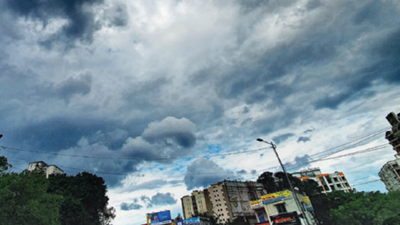Trending
Surge in pollution can cause drop in monsoon rain: Study
Dr. Thara V Prabhakaran and Soumya Samanta from IITM found that higher aerosol levels result in smaller cloud droplets, reducing heavy rainfall occurrences significantly.

PUNE: Increasing pollution could lead to a reduction in rainfall from huge rain-bearing cloud clusters during the onset of monsoon season in India, a new study by researchers at the Indian Institute of Tropical Meteorology (IITM) in Pune has revealed.
The study examined the lifecycle of a well-documented cluster of rain clouds that formed over the Indian peninsula during the early summer monsoon of 2018 in a prevailing dry mid-tropospheric condition.Using state-of-the-art numerical simulations, the researchers investigated how varying levels of aerosols (tiny airborne particles that seed cloud droplet formation) impacted the development and rainfall production of the cloud cluster.

Dr Thara V Prabhakaran, senior scientist at IITM, said, “As aerosol concentrations increased from clean to moderate to heavily polluted levels, there was a notable decrease in the number of convective rain-producing elements within the cloud cluster, especially in its early stage of development. The area covered by intense rainfall types like isolated thunderstorms also shrank considerably in the more polluted scenarios.”
The researchers found that higher aerosol levels led to the formation of smaller cloud droplets. “While this increased total cloud water initially through condensation, the smaller droplet sizes made it harder to produce heavier rainfall. Dry mid-level atmospheric conditions further suppressed cloud growth and rainfall production. Overall rainfall amounts declined markedly with increasing pollution levels,” Samanta said.
“The rising aerosol concentrations essentially affected the microphysical mechanisms that facilitate heavy rain from the rain-bearing monsoon clouds. In the heavily polluted case, there was a substantial reduction in moderate to heavy rainfall occurrences,” he said.
The study said despite this being a case study, the results illustrate how escalating aerosol levels from sources like industrial pollution and dust could severely disrupt rainfall patterns during India’s vital monsoon season, if left unchecked.
One of the interesting findings of the study related to the evaporation rates of cloud droplets. The evaporation rates increased steadily as the levels of aerosols increased. This is likely because the higher aerosol levels led to the formation of a larger number of smaller cloud droplets, which collectively had a greater total surface area exposed to evaporation.
Aerosols originate from various sources. Natural sources include dust, sea salt, volcanic eruptions, wildfires and plant emissions, while human activities contribute through industrial processes, vehicle emissions, agriculture, construction and burning fossil fuels. Biological sources like pollen, spores and microbes also produce aerosols.
The study was recently published in Elsevier’s international journal, Journal of Atmospheric and Solar-Terrestrial Physics.
The study examined the lifecycle of a well-documented cluster of rain clouds that formed over the Indian peninsula during the early summer monsoon of 2018 in a prevailing dry mid-tropospheric condition.Using state-of-the-art numerical simulations, the researchers investigated how varying levels of aerosols (tiny airborne particles that seed cloud droplet formation) impacted the development and rainfall production of the cloud cluster.

Dr Thara V Prabhakaran, senior scientist at IITM, said, “As aerosol concentrations increased from clean to moderate to heavily polluted levels, there was a notable decrease in the number of convective rain-producing elements within the cloud cluster, especially in its early stage of development. The area covered by intense rainfall types like isolated thunderstorms also shrank considerably in the more polluted scenarios.”
“With rising pollution levels, we saw around a 30% reduction in convective elements in the moderately polluted case, and over 50% reduction in the heavily polluted scenario compared to clean conditions,” IITM scientist and lead author of the study Soumya Samanta told TOI.
The researchers found that higher aerosol levels led to the formation of smaller cloud droplets. “While this increased total cloud water initially through condensation, the smaller droplet sizes made it harder to produce heavier rainfall. Dry mid-level atmospheric conditions further suppressed cloud growth and rainfall production. Overall rainfall amounts declined markedly with increasing pollution levels,” Samanta said.
“The rising aerosol concentrations essentially affected the microphysical mechanisms that facilitate heavy rain from the rain-bearing monsoon clouds. In the heavily polluted case, there was a substantial reduction in moderate to heavy rainfall occurrences,” he said.
The study said despite this being a case study, the results illustrate how escalating aerosol levels from sources like industrial pollution and dust could severely disrupt rainfall patterns during India’s vital monsoon season, if left unchecked.
One of the interesting findings of the study related to the evaporation rates of cloud droplets. The evaporation rates increased steadily as the levels of aerosols increased. This is likely because the higher aerosol levels led to the formation of a larger number of smaller cloud droplets, which collectively had a greater total surface area exposed to evaporation.
Aerosols originate from various sources. Natural sources include dust, sea salt, volcanic eruptions, wildfires and plant emissions, while human activities contribute through industrial processes, vehicle emissions, agriculture, construction and burning fossil fuels. Biological sources like pollen, spores and microbes also produce aerosols.
The study was recently published in Elsevier’s international journal, Journal of Atmospheric and Solar-Terrestrial Physics.
End of Article
FOLLOW US ON SOCIAL MEDIA











